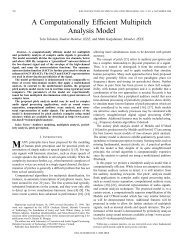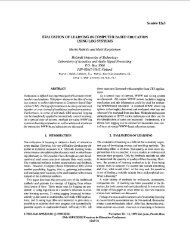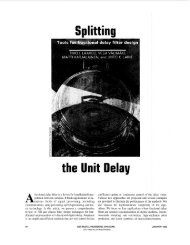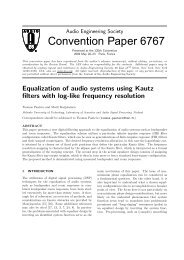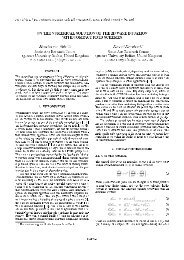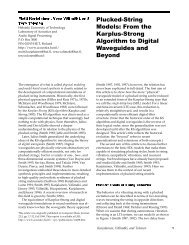Physical Modeling of Plucked String Instruments with Application to ...
Physical Modeling of Plucked String Instruments with Application to ...
Physical Modeling of Plucked String Instruments with Application to ...
Create successful ePaper yourself
Turn your PDF publications into a flip-book with our unique Google optimized e-Paper software.
VALIMAKI ET AL. PAPERSe(n) and b(n) can be combined, as shown in Fig. 14(b). cessing point <strong>of</strong> view and as good as possible from theThe signal x(n) is then used as the input <strong>to</strong> the general- perceptual point <strong>of</strong> view. In earlier studies we have conizedKS string model. The combination <strong>of</strong> the excitation sidered three strategies [34], [37]:signal and the impulse response <strong>of</strong> the body is motivated 1) Directional filteringby the fact that then the body need not be modeled 2) Set <strong>of</strong> elementary sourcesexplicitly during real-time synthesis. The signal x(n) 3) Direction-dependent excitation.combining the excitation and the body response can be A direction-dependent digital filter may be attachedestimated by precomputing it based on some model, by <strong>to</strong> each path from the source <strong>to</strong> the listener. Moving andmeasuring it somehow, or by inverse filtering a digital rotating sources can be modeled by changing the filterrecording <strong>of</strong> an instrument, as will be discussed in Sec- parameters <strong>of</strong> the paths in a proper way (for example,tion 3.5.theLeslieeffect<strong>of</strong> a rotatingloudspeakercan be simu-We may develop the model further by explicitly mod- lated). The directional filtering method was studied foreling the excitation signal. The first step <strong>to</strong>ward this the acoustic guitar. We came <strong>to</strong> the conclusion that evendirection is <strong>to</strong> extract the most prominent resonances <strong>of</strong> first- or second-order directivity filters give useful rethebody, measure their central frequencies and Q val- suits, thus leading <strong>to</strong> an efficient implementation.ues, and design a second-order all-pole filter <strong>to</strong> represent Fig. 15 depicts the modeling <strong>of</strong> direction-dependenteach resonance. These resonances must then be removed radiation <strong>of</strong> the acoustic guitar (in the horizontal plane)from the excitation signal, for example, by using nar- relative <strong>to</strong> the main-axis radiation. Shown in the figurerow-band linear-phase FIR filters,are magnitude spectra for second-order IIR filters at azi-We have successfully extracted the two lowest reso- muth angles <strong>of</strong> 90, 135, and 180°. The reference magninances<strong>of</strong> the body <strong>of</strong> an acoustic guitar. The main ad- tude spectrum at 0 ° is assumed <strong>to</strong> be flat. The lowvantage<strong>of</strong> this approach is that the residual signal <strong>with</strong> pass characteristic is noticeably increased as the relativethe low-frequency high-Q resonances removed decays angle is greater. The measurement was carried out bymore rapidly than the original one. As a consequence, exciting the bridge <strong>of</strong> the instrument using an impulsea shorter excitation signal can be used, and the memory hammer and registering the reference response at 0° andrequirements for the model-based synthesizer are low- the related response in various directions. The measuredered. Also, the Q values and the central frequencies <strong>of</strong> reference and the directional response were fitted sepathelowest resonances are now parameterized and thus rately <strong>with</strong> first- or second-order AR models. A simpleindependently controllable,division <strong>of</strong> the models was performed <strong>to</strong> obtain thepole-zero directivity filter.2.5 <strong>Modeling</strong> Directional Properties <strong>of</strong> <strong>String</strong> Fig. 16(a) shows the transfer function measured at<strong>Instruments</strong> azimuth angles <strong>of</strong> 0 and 180 °. Fig. 16(b) gives the re-The directional characteristics <strong>of</strong> musical instrument sponse at 0° filtered <strong>with</strong> a first-order IIR directivitysound radiation are <strong>of</strong> interest in several applications filter and the actual measured response at 180 ° azimuth.using model-based sound synthesis. From the scientific Note that the spectral slopes are nearly the same, as waspoint <strong>of</strong> view the physical modeling approach serves as expected. In this example the transfer function <strong>of</strong> thea flexible <strong>to</strong>ol for analysis and simulation <strong>of</strong> the directiv- directional filter isity <strong>of</strong> the instruments. Directional characteristics mustbe taken in<strong>to</strong> account when model-based sound synthesismethods are used for sound generation in room acousticsR (z) - bo + biz- l1 + a]z- _ (10)simulation and other virtual reality applications [34],[36].<strong>Plucked</strong> string instruments exhibit complex sound ra- o ____






